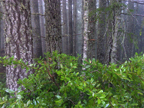Annotated Bibliography For the Years 1826 - 1900
5. Academicians: Byram, Hall, Losey, Schwarz, Tveskov, Wasson
In recent years a significant amount of anthropological and archaeological research has been performed along the southwest Oregon coast that is complementary to the historical research currently being conducted. Scientists and graduate students affiliated with Southern Oregon University, the University of Oregon, and Oregon State University have performed much of this work in cooperation with the Coquille Indian Tribe. Although a number of the listed scientists have not actually written books on their research, all have written important book-length theses, dissertations, and reports of significant value to the Tribe, the local community, and to other scientists and writers. And, although these types of work have often been difficult to locate and secure in the past, recent advances in Internet communications and PDF software are resulting in increased access to these materials.
Byram has been a primary source of precontact and early historical information along the Oregon Coast with his archaeological study of ancient and more recent fish weirs; including locations in the current study area that had been used up for thousands of years, until historical time (Byram 2002). While doing research on his dissertation, he also worked extensively with the Tribe conducting cultural resource inventories (e.g., Byram and Ivy 2001), writing and editing portions of the publications resulting from a series of Coquille Cultural Conferences in the late 1990s and early 2000s, and continuing to perform both tidal and upland research in southwest Oregon.
Hall performed a number of research projects for the Coquille Tribe for many years, resulting in a several publications detailing her work with oral histories, archaeology, physiological analysis, and human adaptation to the environment. In addition to her research reports, she has published several useful books on these topics, including The Coquille Indians: Yesterday, Today and Tomorrow in 1991, and People of the Coquille Estuary in 1995, which summarize much of her earlier research on these topics. Hall has enjoyed long-term research relationships with many Tribal members, particularly during her oral history research, and this has led to a number of relevant findings perhaps unavailable to others.
Losey’s doctoral research at the University of Oregon used the archaeological record and oral traditions to determine how an earthquake and subsequent tsunami in 1700 may have affected Oregon coastal people. Although his 2002 dissertation, Communities and Catastrophe: The Tillamook Response to the AD1700 Earthquake and Tsunami, Northern Oregon Coast, focuses on an area to the north of the study area and more than 100 years earlier than the study’s timeframe, his findings have significant value considering all coastal people and landforms affected by this catastrophic event. Losey analyzes the house architecture, residential patterns, foods, technologies, social organization, and appearance of tsunamis and earthquakes in oral tradition of Native coastal people to understand the complex ways people and environments have responded to earthquakes and tsunamis along what is now the Oregon Coast. In recent years he has collaborated with Byram on pursuing this topic, while broadening his field to examine the role of domesticated dogs in archaeological research.
Schwartz’s popular 1997 book, The Rogue River Indian War and Its Aftermath, 1850 - 1980, is derived from his PhD dissertation the same topic. Although there has been little apparent follow-up to this work, Schwartz has been instrumental in getting documentary information online that is of great value to other researchers. That being said, there is really very little to recommend this book for the purposes of this study, particularly when compared to the works of Victor and Walling (despite book jacket claims that this is the “first detailed history” on this topic). Schwartz is thorough in his citations of obscure references from newspapers and private correspondence, among other historical sources, but seems to gloss over potentially important events in order to develop his narrative on subsequent history of the Grand Ronde and Siletz Reservations.
Tveskov’s doctoral research, summarized in his 2000 dissertation, The Coos and Coquille Indians: A Historical Anthropology of the Northwest Coast, is of the most specific value to current historical research. In many ways, this is ground-breaking work in its attention to the journals, military reports, and other sources of previously obscure information detailing the earliest histories of the Coos and Coquille people; including detailed examinations of their daily and community lives. This, and subsequent research by Tveskov (e.g., 2004), expertly incorporates the findings of Byram, Losey, and others, placing their research in direct context to the more general history of the Coos and Coquille Tribes.
Wasson uses family photographs, interviews, personal recollections, and developing archaeological and anthropological sources in his 2002 PhD dissertation in an effort to reconstruct the history of his ancestors along Coos Bay and the Coquille River. Prior to Wasson’s efforts and the efforts of Hall, Byram, and others to learn more regarding these topics in recent years (e.g., Zybach and Wasson 2009), his characterization of southwest Oregon history as a “Black Hole” is both descriptive and largely accurate. His research purpose and design provide a fitting summary to this report (Wasson 2002: 98-99):
My approach to rediscovering and understanding the cultural contents of that “Black Hole” is to examine those characteristics of neighboring tribes for whom there is fairly adequate information and draw parallel inferences about the lost information. The Coquelles are a group from that “Black Hole,” and I propose to look at the “bits and pieces” of surviving knowledge about them in an effort to reconstruct (as adequately as feasible) their lost and forgotten cultural heritage. |
***********************
References to Coquelle Trails Report, Vols. I & II: www.ORWW.org/Coquelle_Trails/References/index.html [PDF_xxx_KB]
Annotated Bibliography to Coquelle Trails History: www.ORWW.org/Coquelle_Trails/References/Zybach-Ivy_2013/Volume_I/Part_3.html [PDF_204_KB]
References to General Land Office Surveyors' Field Notes: www.ORWW.org/Coquelle_Trails/Land_Surveys/References.html
References to Southwest Oregon Indian History: www.NWMapsCo.com/ZybachB/Reports/2007_Newton_OSU-BLM/index.html [PDF_37_KB]
References to South Umpqua River History: www.ORWW.org/Rivers/Umpqua/South/References/index.html
References to Southwest Oregon Wildfire History and Sciences: www.ORWW.org/Wildfires/Biscuit/References/Index.html
